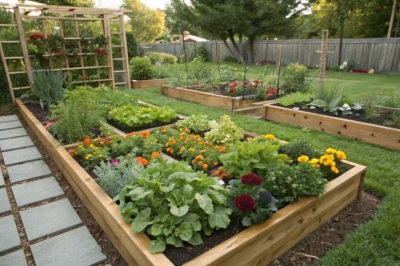1. Raised Bed Revolution
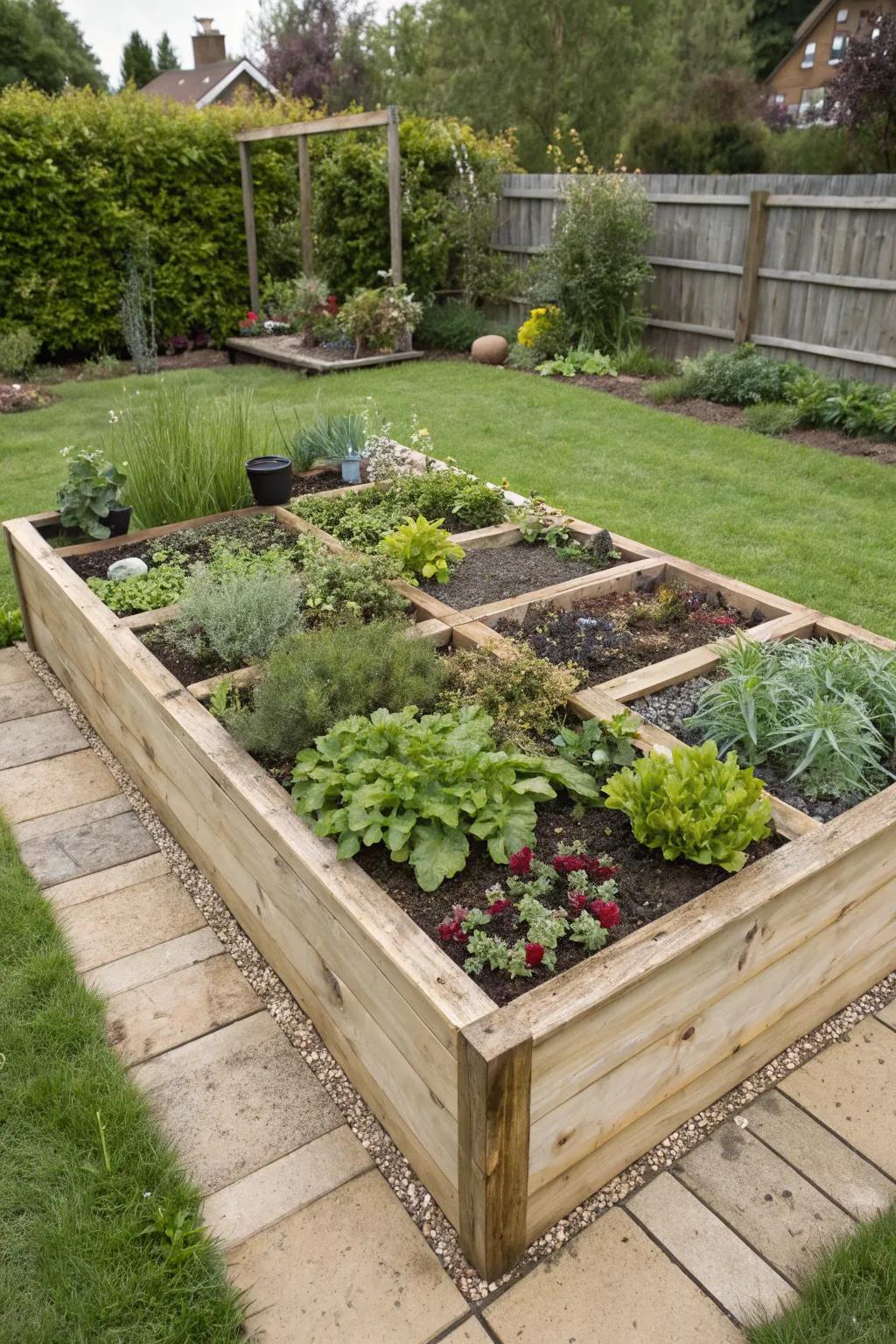
Raised beds are a game-changer, especially if, like me, you’re working with less-than-ideal soil. They’re perfect for organizing your square foot garden and keeping everything neat and tidy.
Check these products out:
- Wooden Raised Garden Bed Kit: Enhance your garden layout with easy-to-assemble raised bed kits for organized planting.
- Square Foot Gardening Grid: Maximize planting space efficiently with a durable grid for perfect square foot gardening.
- Organic Soil Mix for Raised Beds: Provide your plants with rich nutrients using an organic soil blend specifically for raised beds.
2. Grid It Up
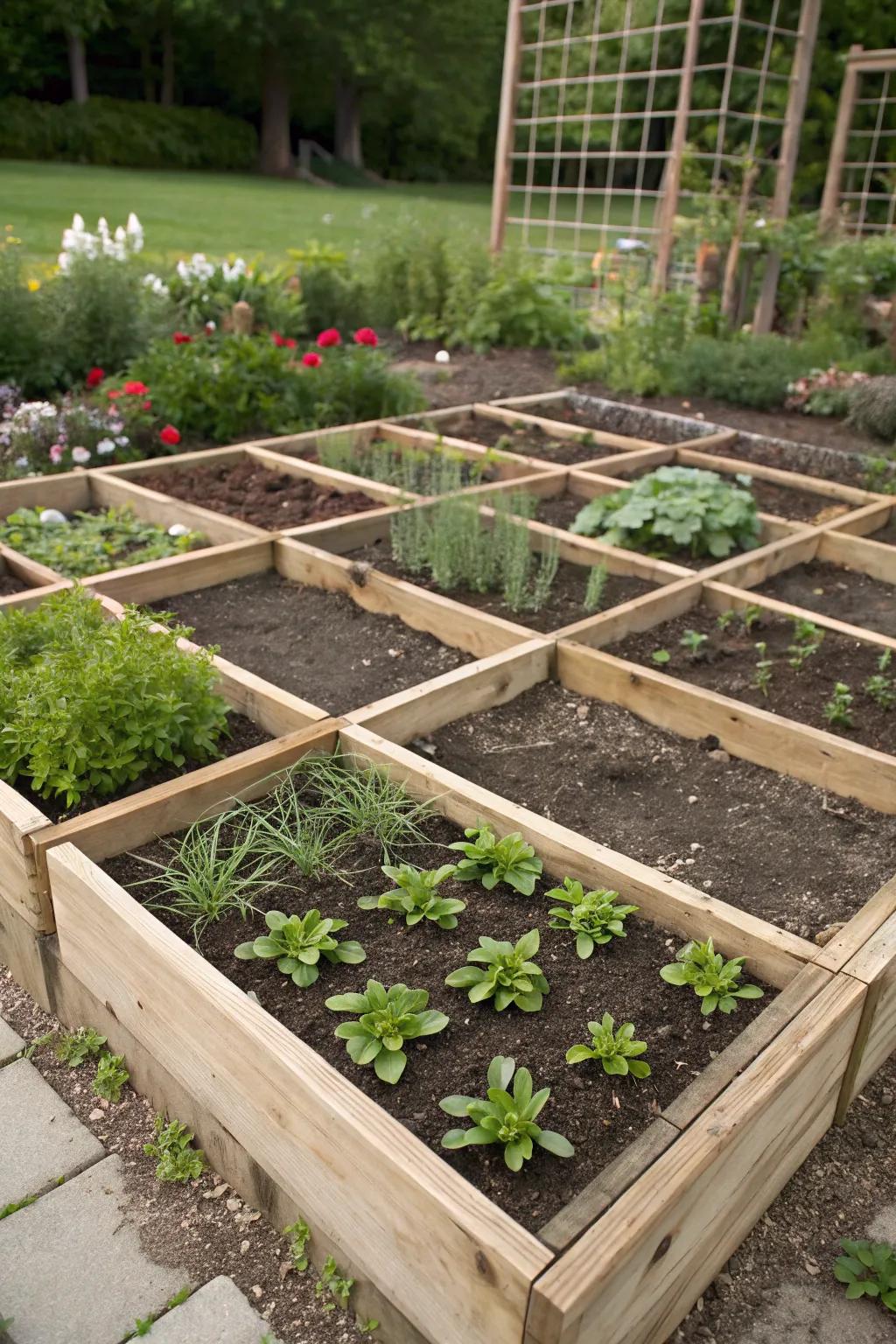
Creating a grid layout is key to square foot gardening, as it helps keep everything organized. I love using wooden slats or strings to mark each square foot, making planting a breeze.
Check if these fit your needs:
- Wooden Garden Slats: Define your garden grid with durable wooden slats, ensuring straight and neat rows effortlessly.
- Planting Grid String: Create precise planting grids using string. Perfect for customizable and easy-to-change layouts.
- Square Foot Gardening Grid Kit: Simplify garden organization with a ready-to-use square foot gardening grid kit.
3. Play with Heights
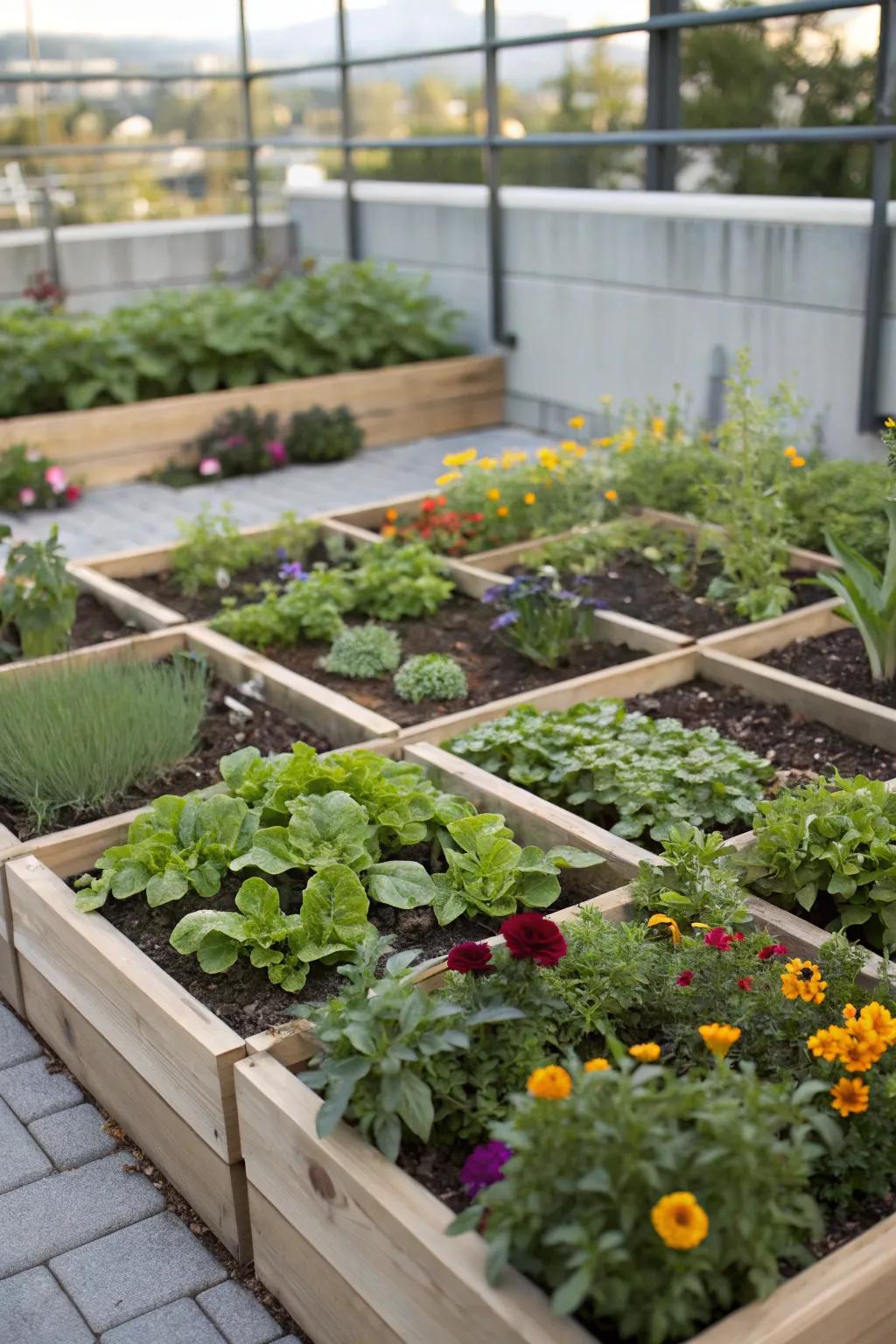
Vary plant heights within your squares for visual interest. Tall corn next to low-lying greens creates a lovely layered effect.
A few suggestions:
- Adjustable Plant Supports: Maximize vertical growth with adjustable plant supports. Create diverse height levels in your square foot garden.
- Stackable Planter Boxes: Add tiers to your garden with stackable planter boxes to diversify plant heights effortlessly.
- Garden Trellis for Vegetables: Encourage vertical growth by using a garden trellis. Ideal for beans or climbing plants.
4. Seasonal Swaps

Rotate plants with the seasons to keep your garden productive year-round. It’s like changing up a wardrobe, but with plants!
You might like:
- Raised Garden Bed Kit: Elevate your gardening game by easily rotating crops with this sturdy, season-friendly garden bed.
- Plant Rotation Planner: Stay organized and maximize yield by planning seasonal crop rotations effectively.
- Seasonal Seed Packets: Keep your garden thriving all year with a diverse selection of seasonal seeds.
5. Color Coordinate
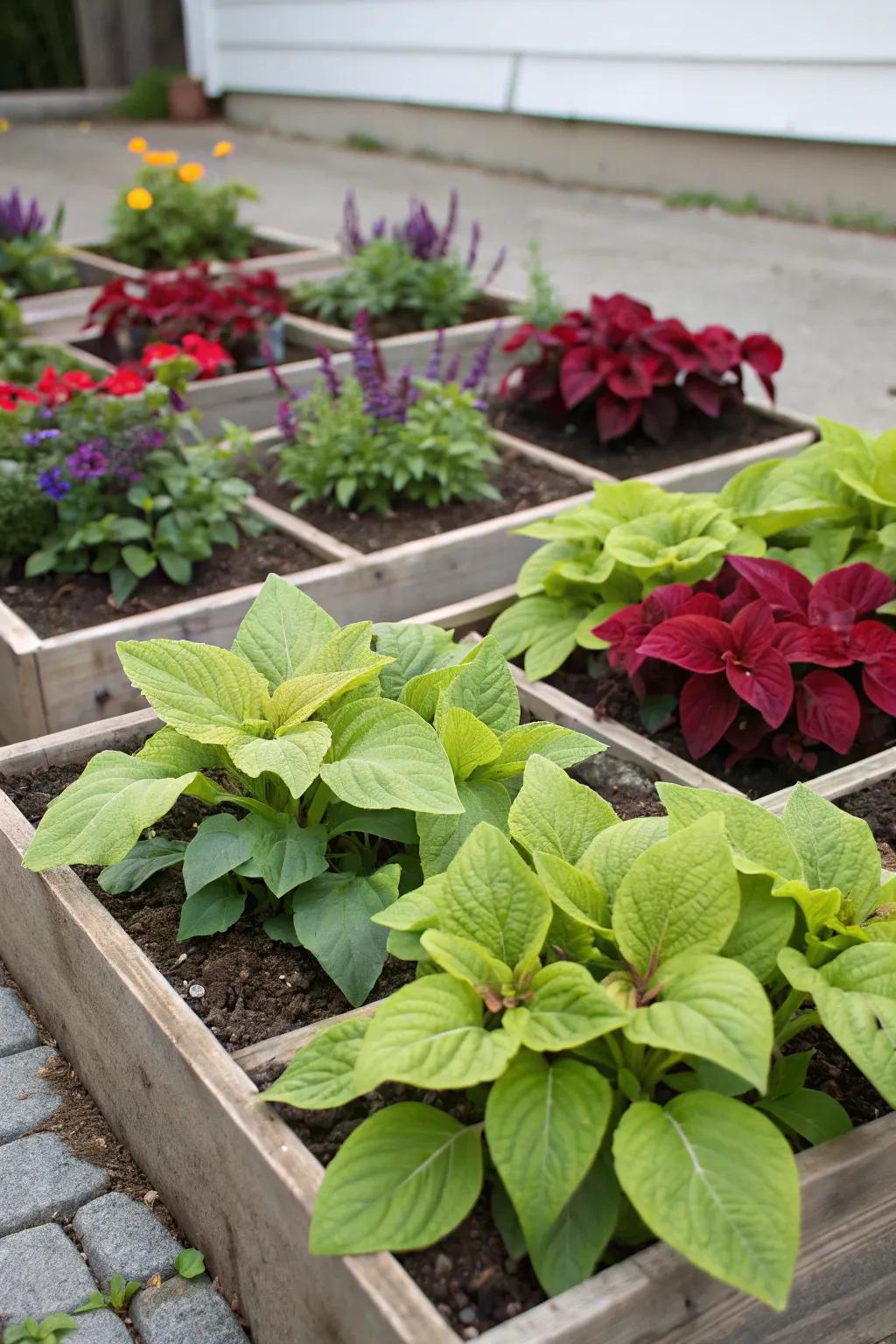
Choose plants based on complementary colors for a cohesive look. I love pairing purple basil with vibrant green lettuce.
A few things you might like:
- Square Foot Gardening Planters: Enhance your garden’s beauty with compact planters perfect for organizing colorful plants elegantly.
- Organic Purple Basil Seeds: Add vibrant color and flavor to your garden with these easy-to-grow organic purple basil seeds.
- Vibrant Lettuce Seed Pack: Grow crisp, vibrant lettuce to complement colorful arrangements in your square foot garden plot.
6. Herb Haven
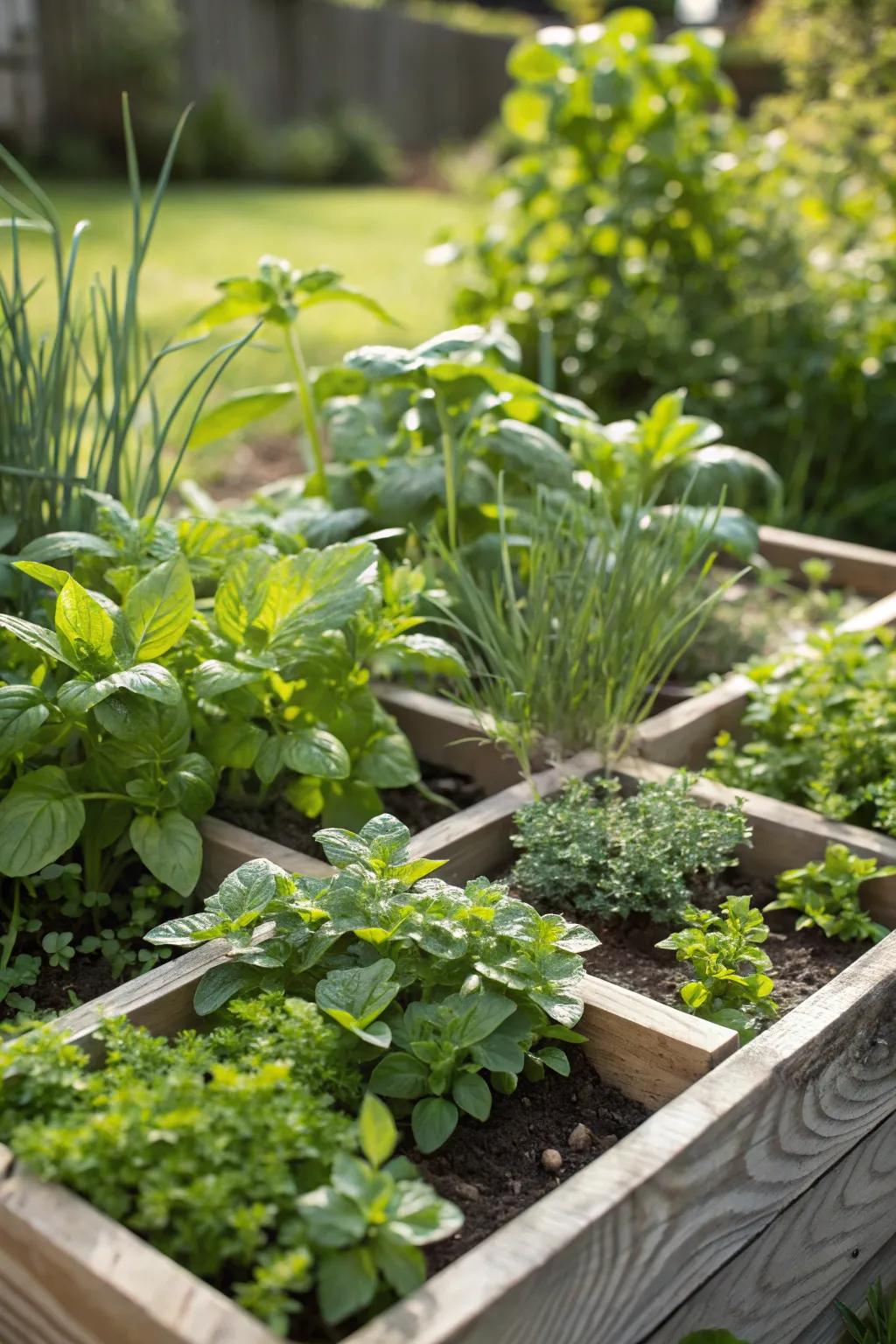
Dedicate a square foot or two to herbs for a fragrant addition. I always have fresh basil, parsley, and cilantro at arm’s reach for my culinary adventures.
Items that may come in handy:
- Wooden Raised Garden Bed: Enhance your garden setup with this charming wooden raised bed to grow herbs efficiently.
- Herb Planter Starter Kit: Kickstart your herb garden with this complete starter kit for easy and fresh herb growth.
- Organic Potting Soil Mix: Nurture your herbs with nutrient-rich organic soil perfect for enhancing plant health and growth.
7. Pollinator Paradise
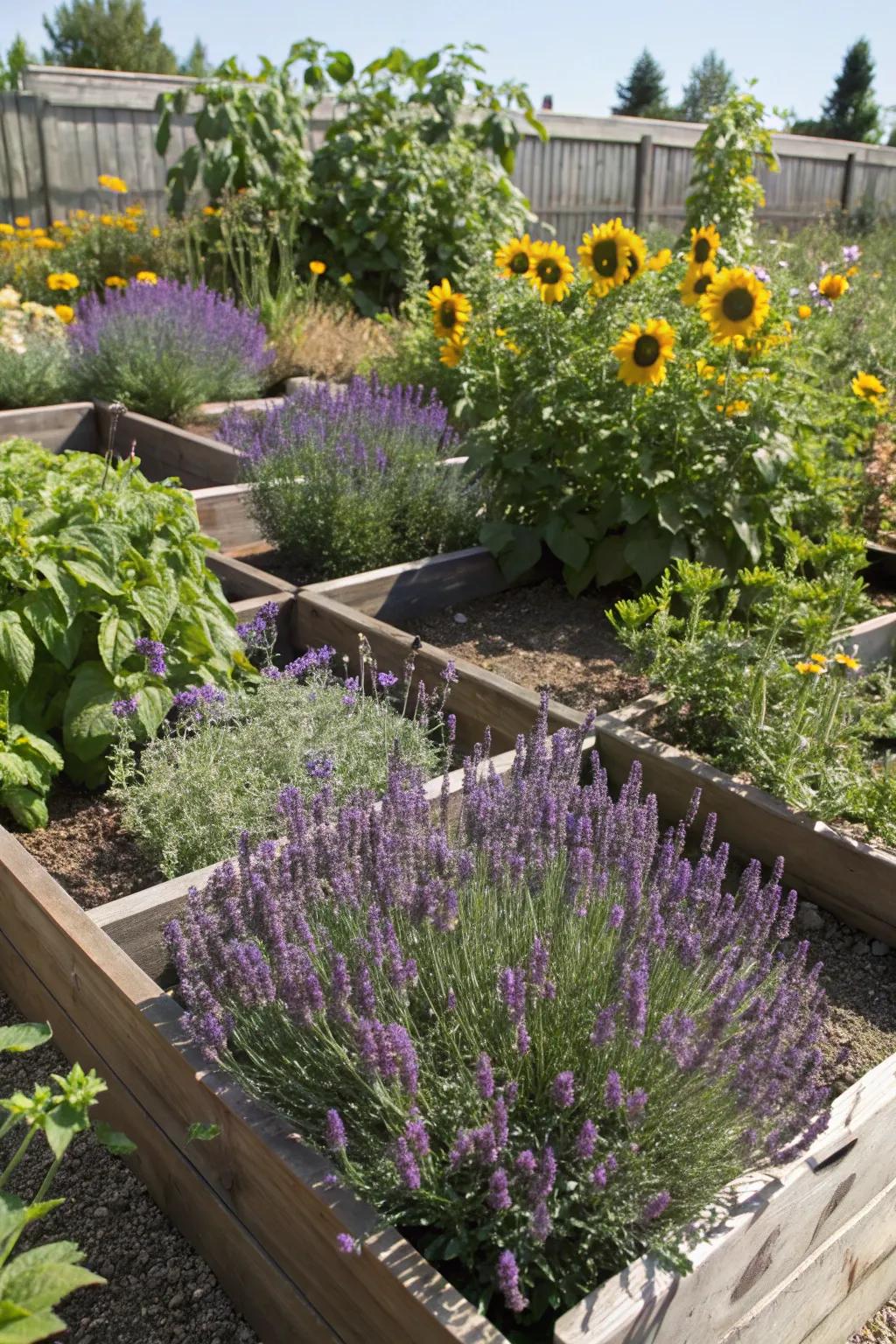
Include plants that attract pollinators, like lavender and sunflowers. Watching bees and butterflies visit is its own reward.
Maybe worth checking out:
- Lavender Seeds for Planting: Grow fragrant lavender to attract bees and butterflies while enhancing your garden’s beauty.
- Sunflower Seeds Variety Pack: Plant vibrant sunflowers to invite pollinators and add a cheerful touch to your garden.
- Bee and Butterfly Habitat Kit: Create a welcoming environment for pollinators with this easy-to-set-up habitat kit.
8. Garden in a Box
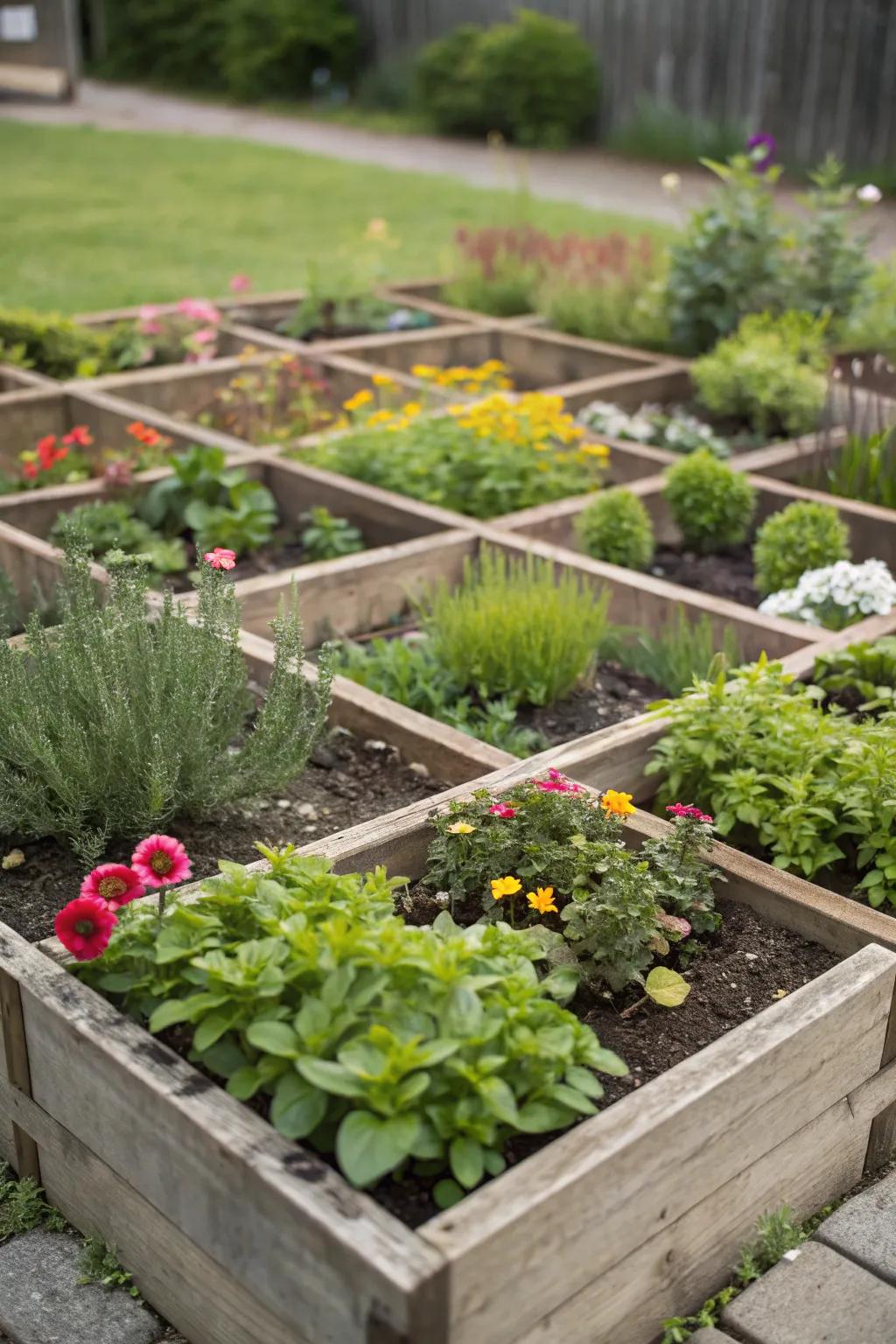
Try creating a mini garden in a box with a mix of plants for a self-contained garden solution. It’s like having a little piece of paradise in a compact form.
Might be a good match:
- Raised Garden Planter Box: Enhance your outdoor space with a sturdy raised planter box for a thriving mini garden.
- Organic Vegetable Seed Kit: Cultivate a vibrant garden effortlessly with this comprehensive organic vegetable seed kit.
- Gardening Hand Tool Set: Equip yourself with essential tools for cultivating and maintaining your garden box efficiently.
9. Shade Solutions
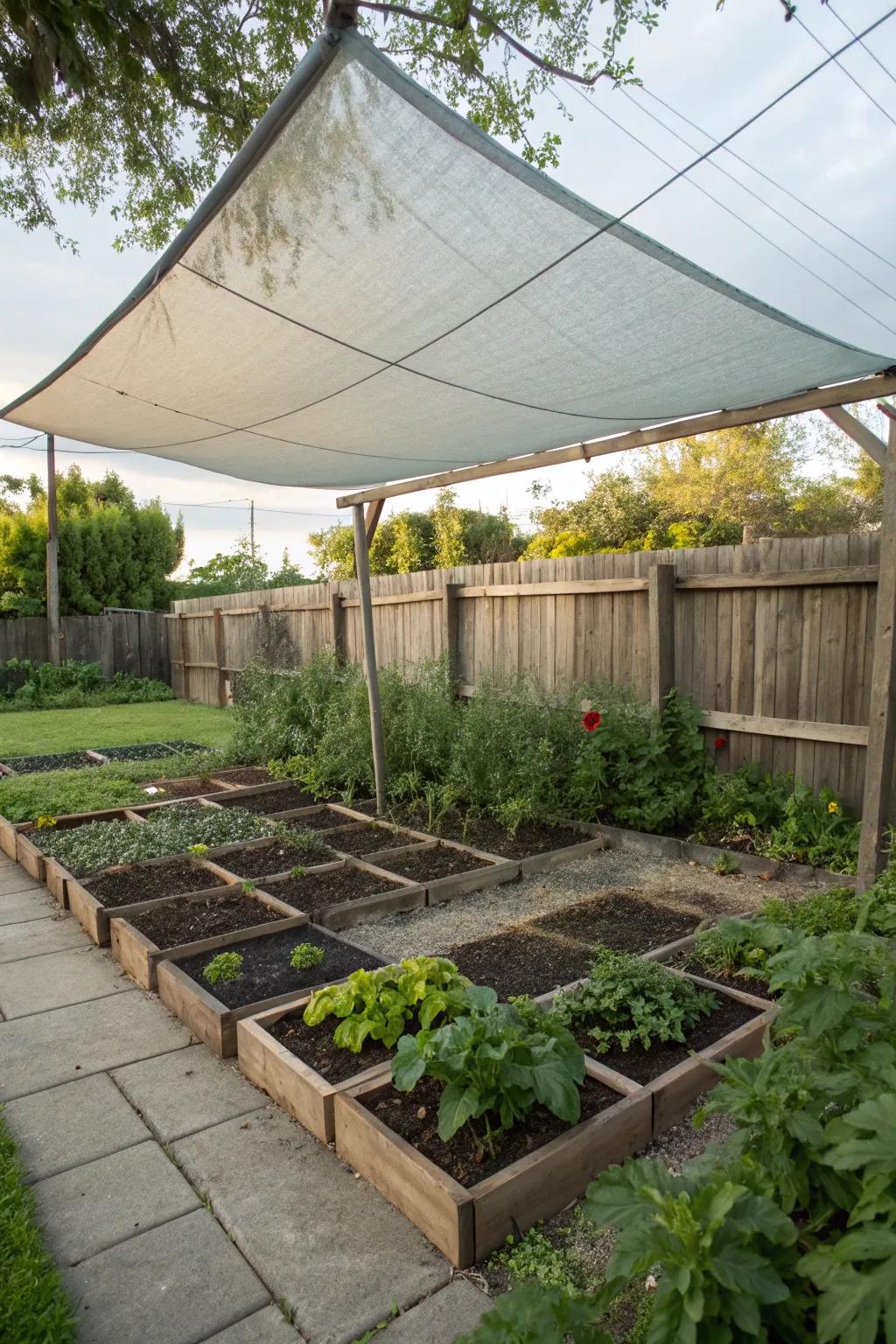
Use shade cloths or pergolas to protect plants from harsh sun. It’s like giving your garden a little parasol.
Useful items to consider:
- Heavy Duty Shade Cloth: Protect your plants with a durable shade cloth, offering essential sunshade to your garden.
- Adjustable Garden Pergola Kit: Assemble an elegant pergola easily, providing versatile shade for your garden’s sunny spots.
- Outdoor UV Protection Sun Shade Sail: Install a UV protection sun sail to shield your plants from intense sunlight effortlessly.
10. Companion Planting
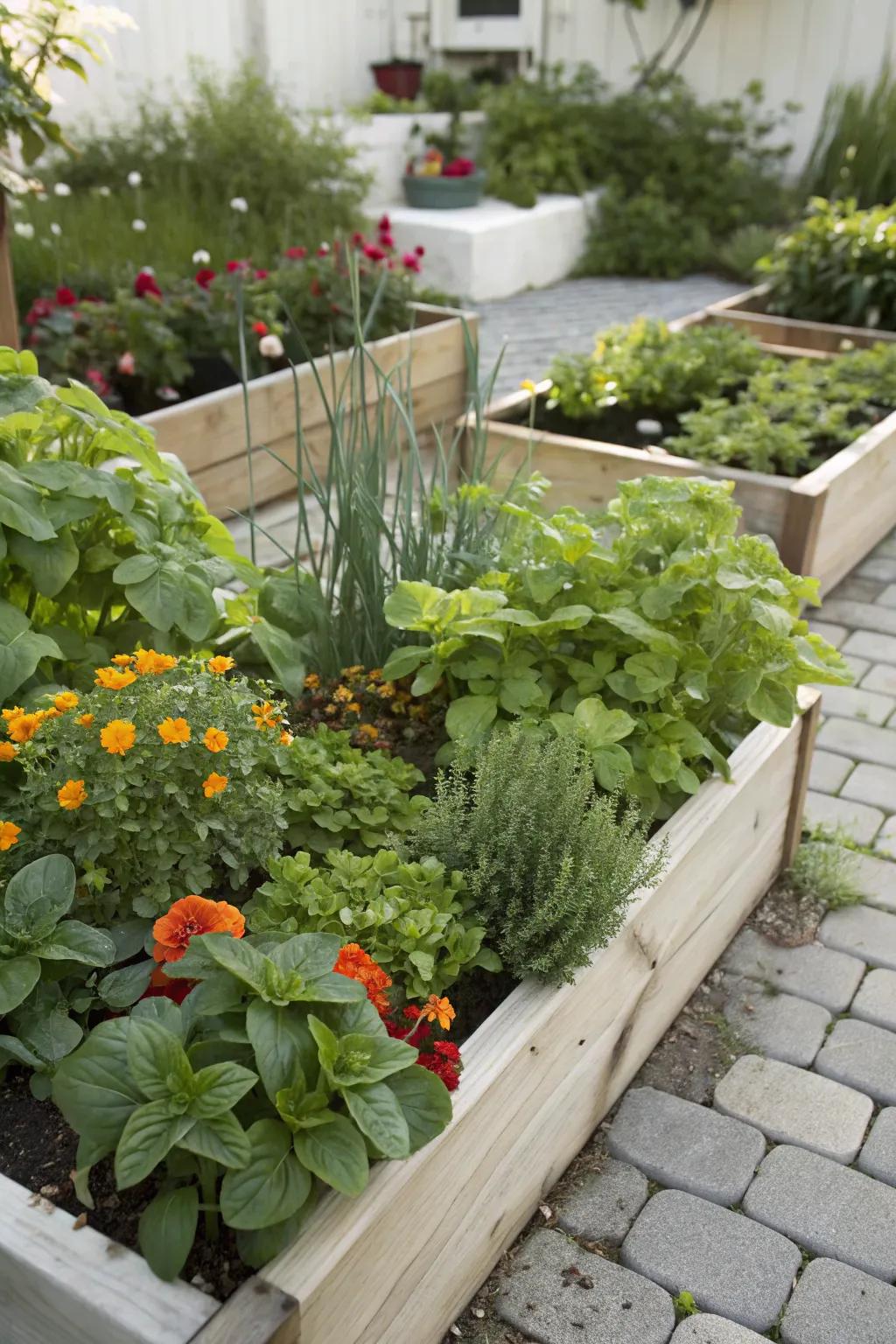
Mixing herbs, flowers, and veggies not only looks pretty but can also deter pests naturally. My basil and tomatoes have been best pals for years!
May just do the trick:
- Herb and Vegetable Seed Set: Jump-start your garden with a diverse seed set ideal for companion planting enthusiasts.
- Natural Pest Control Spray: Protect your plants naturally with this eco-friendly pest control spray for a healthier garden.
- Raised Garden Bed Kit: Enhance your companion planting setup with this easy-to-assemble raised garden bed kit.
11. Dense Planting Delight
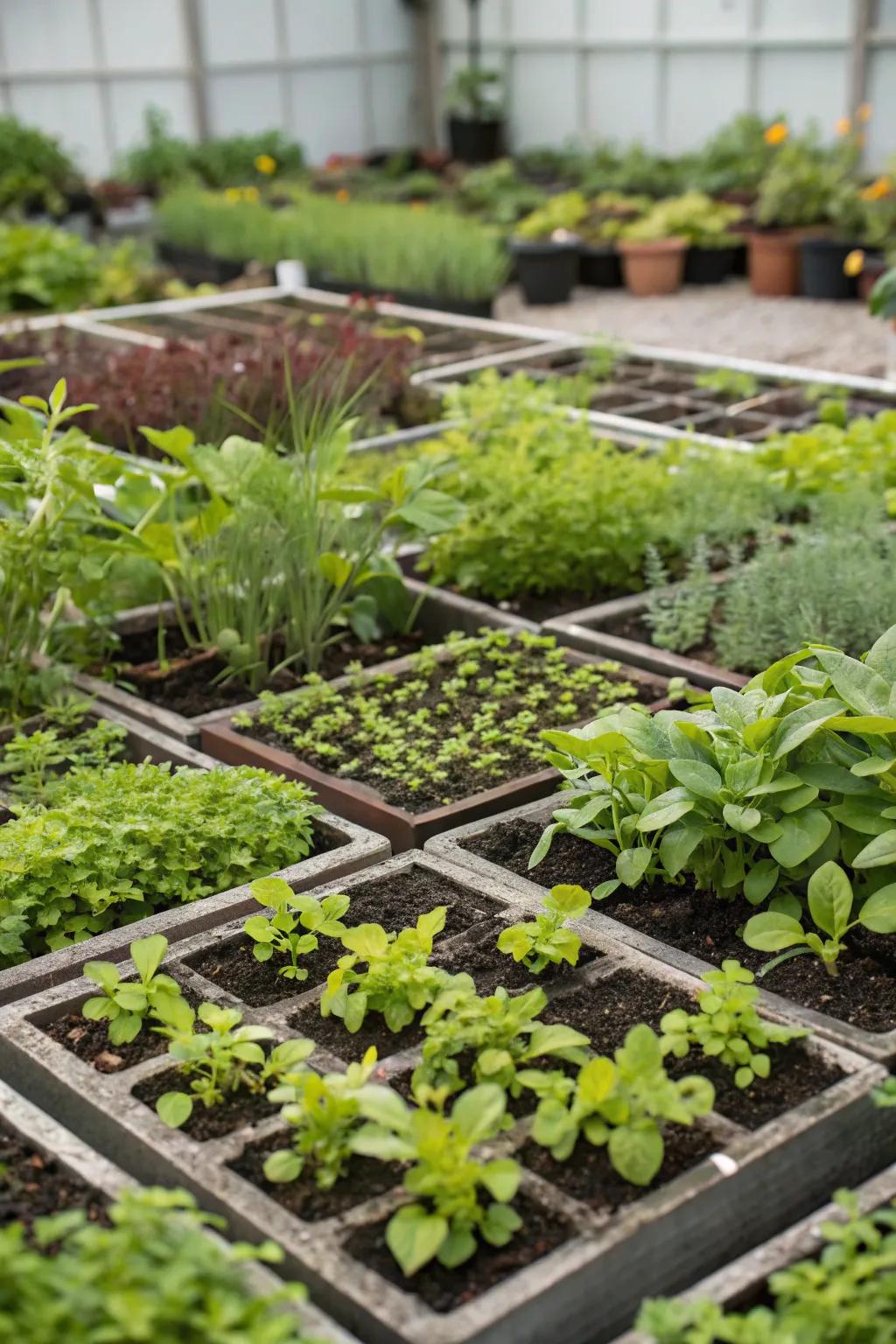
Each square foot can be home to multiple plants, depending on their size. It’s incredible to see how much you can fit into just one tiny square!
Consider these options:
- Square Foot Gardening Grid: Organize your garden efficiently with a grid that’s perfect for dense planting strategies.
- Compact Garden Trowel: Easily plant and manage your dense garden layout with this sturdy and compact trowel.
- Garden Soil Mix for Vegetables: Provide optimal nutrition for your densely planted crops with this rich garden soil blend.
12. Water Wonders
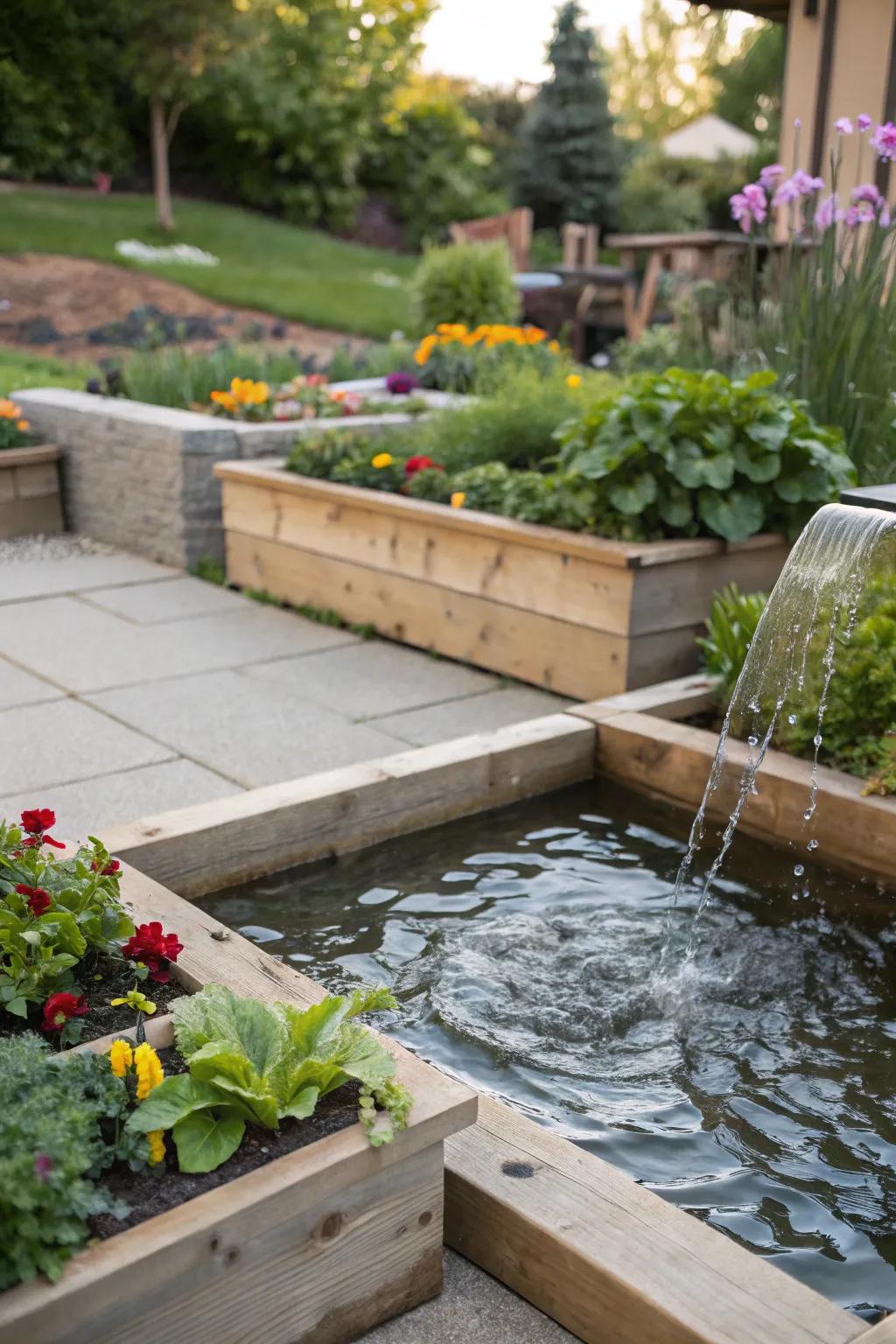
Install a small water feature nearby to attract wildlife and add a tranquil sound. The gentle trickle can be incredibly soothing.
Try these:
- Outdoor Water Fountain: Enhance your garden with a serene water fountain, bringing tranquility and charm to your space.
- Solar Water Pump Kit: Install a solar pump for an eco-friendly water feature, adding soothing sounds to your garden.
- Garden Pond Kit: Create a relaxing pond in your garden with this comprehensive kit, attracting wildlife effortlessly.
13. Incorporate Art
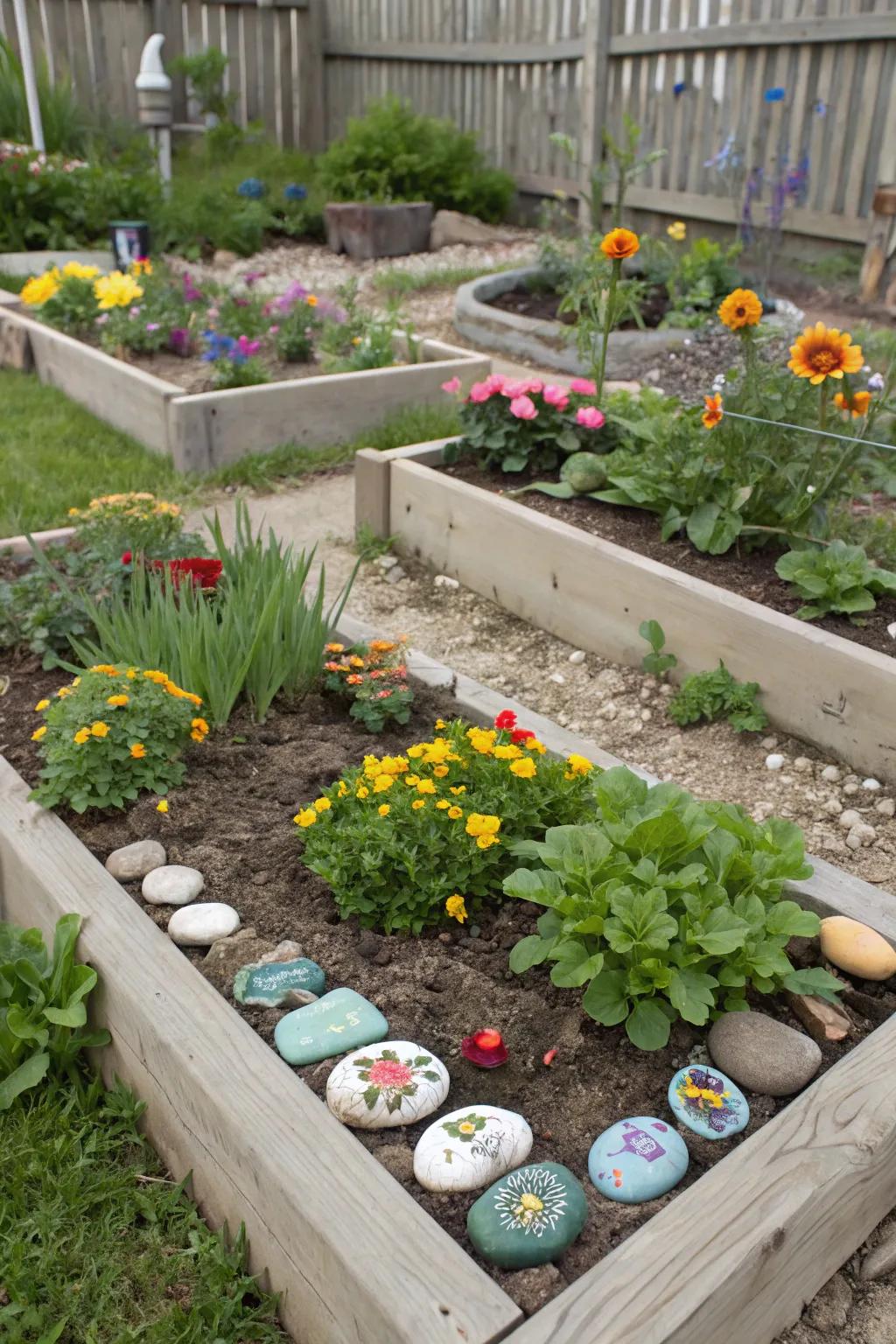
Add artistic elements like small sculptures or painted stones. It’s a personal touch that makes the garden uniquely yours.
Possibly helpful picks:
- Garden Sculpture Set: Enhance your garden’s charm with these elegant sculptures. Add a personal artistic touch today.
- Painted Garden Stones: Personalize your garden space with these beautifully painted stones. Start your garden art project.
- Garden Art Kits: Create unique garden art effortlessly with these complete art kits. Unleash your creativity now.
14. Flower Power
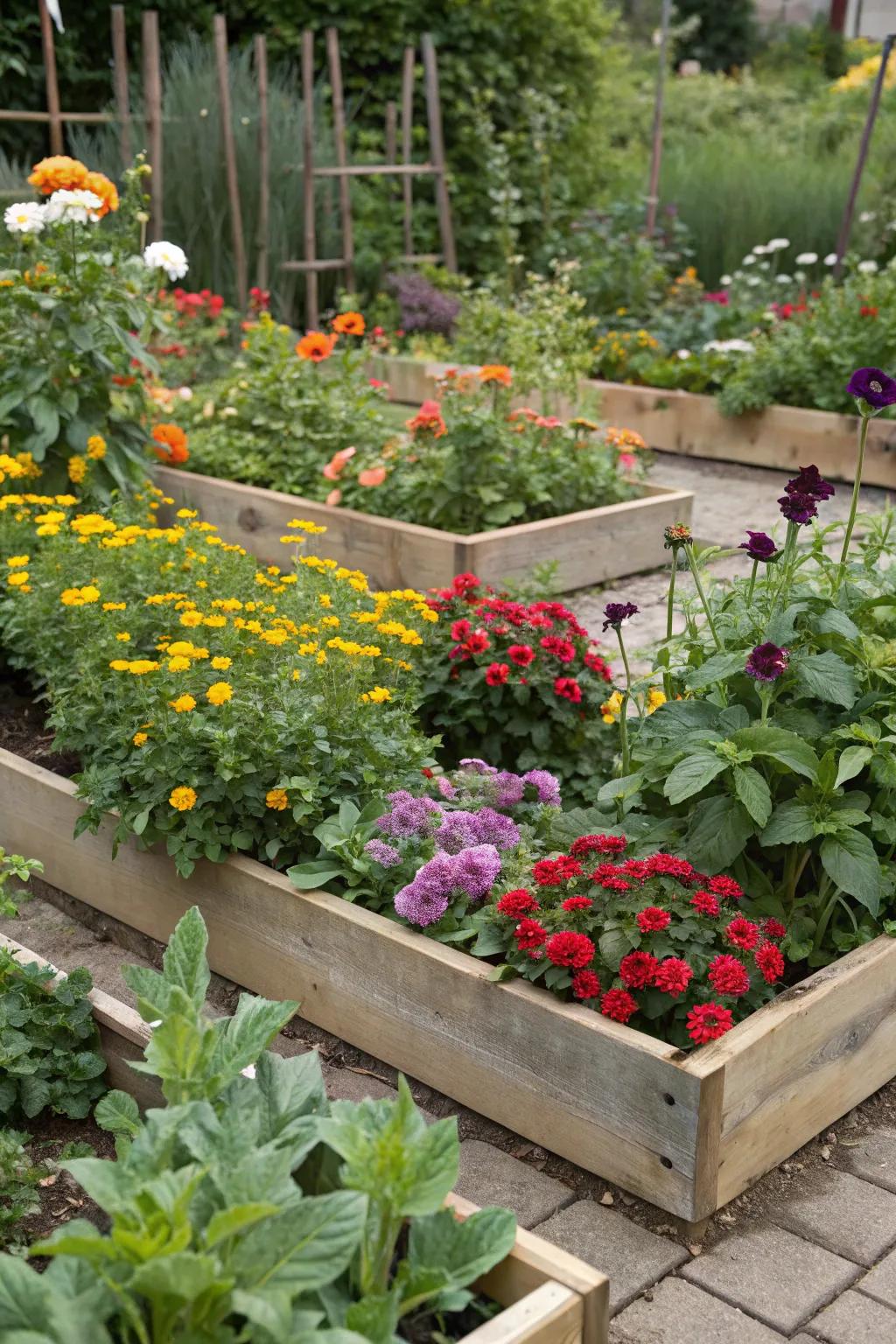
Add some flowers to your squares for a splash of color and to attract pollinators. My marigolds are always buzzing with bees.
These products might help:
- Marigold Seed Packets: Brighten your garden and lure bees effortlessly with vibrant marigold seeds.
- Organic Flower Fertilizer: Enhance your blooms with this organic fertilizer, perfect for robust flower growth.
- Raised Garden Bed Kit: Elevate your flower planting experience with a durable, easy-to-assemble garden bed kit.
15. Themed Gardens
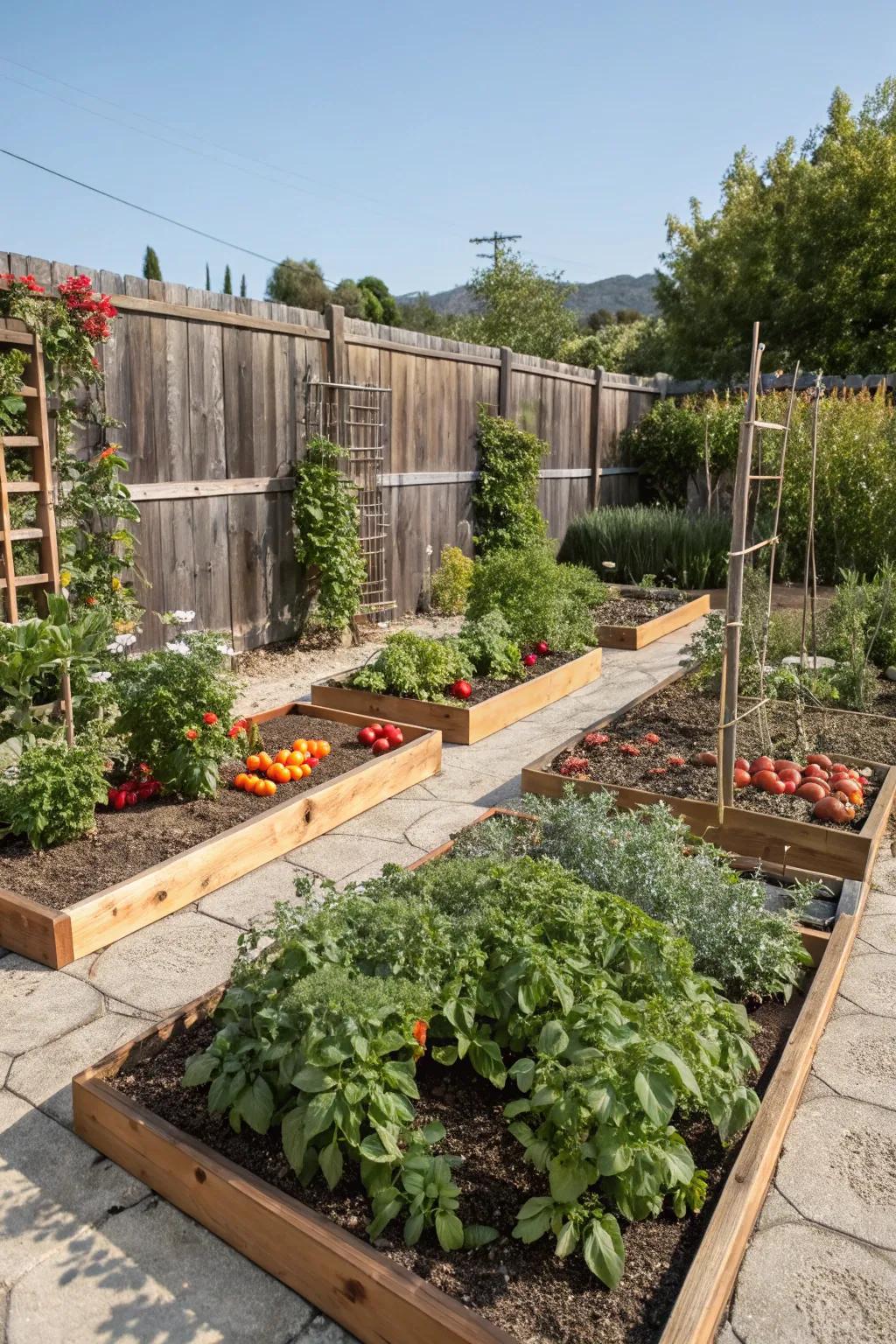
Create themed gardens, like a pizza garden with tomatoes, basil, and oregano. It’s a fun way to design your plantings.
Possibly handy products:
- Wooden Raised Garden Bed Kit: Build your themed garden easily with this wooden raised bed kit, perfect for any yard.
- Organic Herb Seed Pack: Start your pizza garden with this organic herb seed pack including basil and oregano.
- Garden Trellis for Climbing Plants: Support your tomato plants with a sturdy garden trellis, ideal for vertical gardening.
16. Succulent Squares
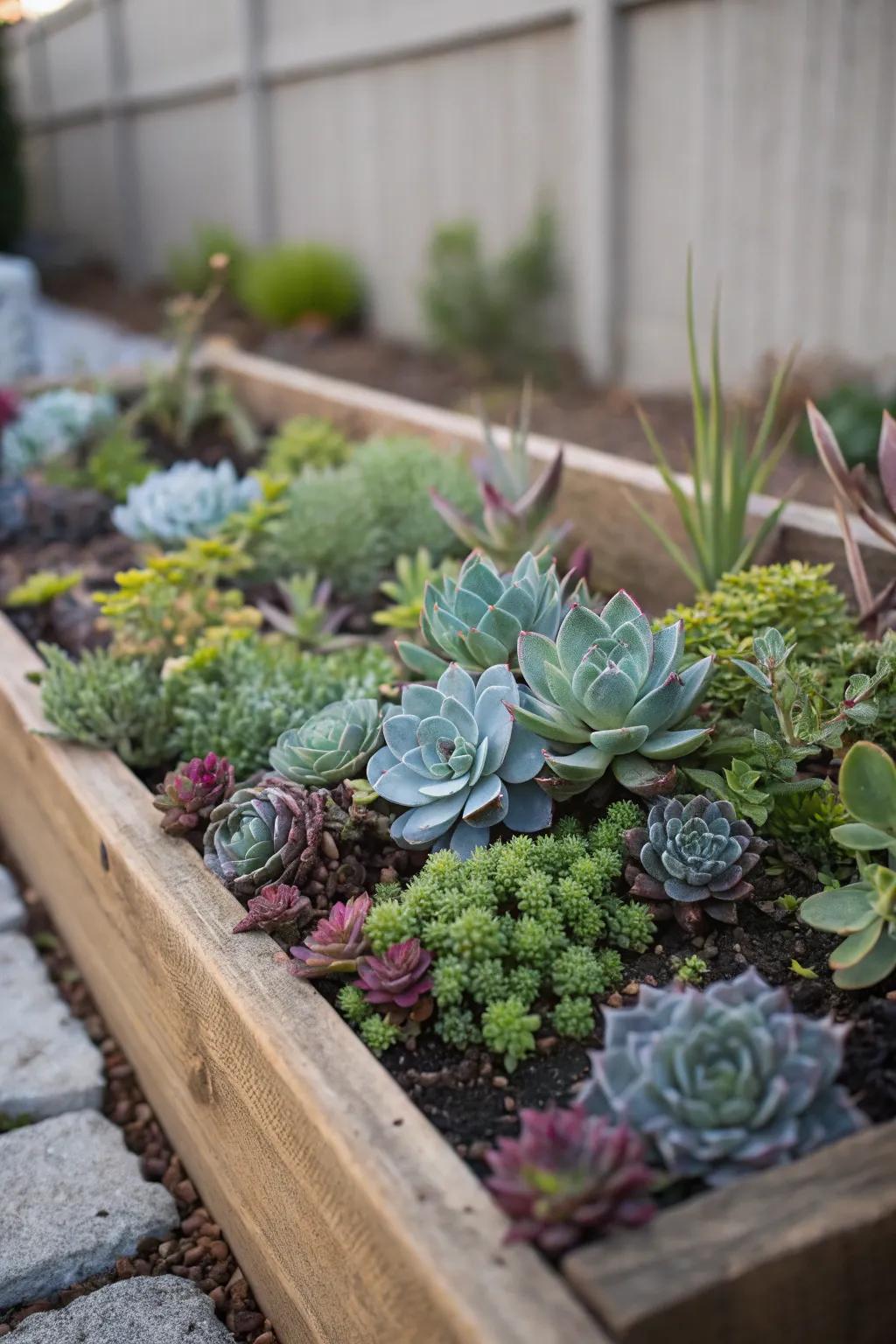
Try dedicating a square to drought-tolerant succulents. They’re low maintenance and add a unique texture to your garden.
A few relevant products:
- Assorted Succulent Plants: Enhance your garden with vibrant, drought-tolerant succulents that thrive in any setting.
- Wooden Planter Boxes: Create a stylish succulent display with durable, rustic wooden planter boxes.
- Soil Mix for Succulents: Ensure optimal growth by using a specially formulated soil mix for succulents.
17. Container Creativity
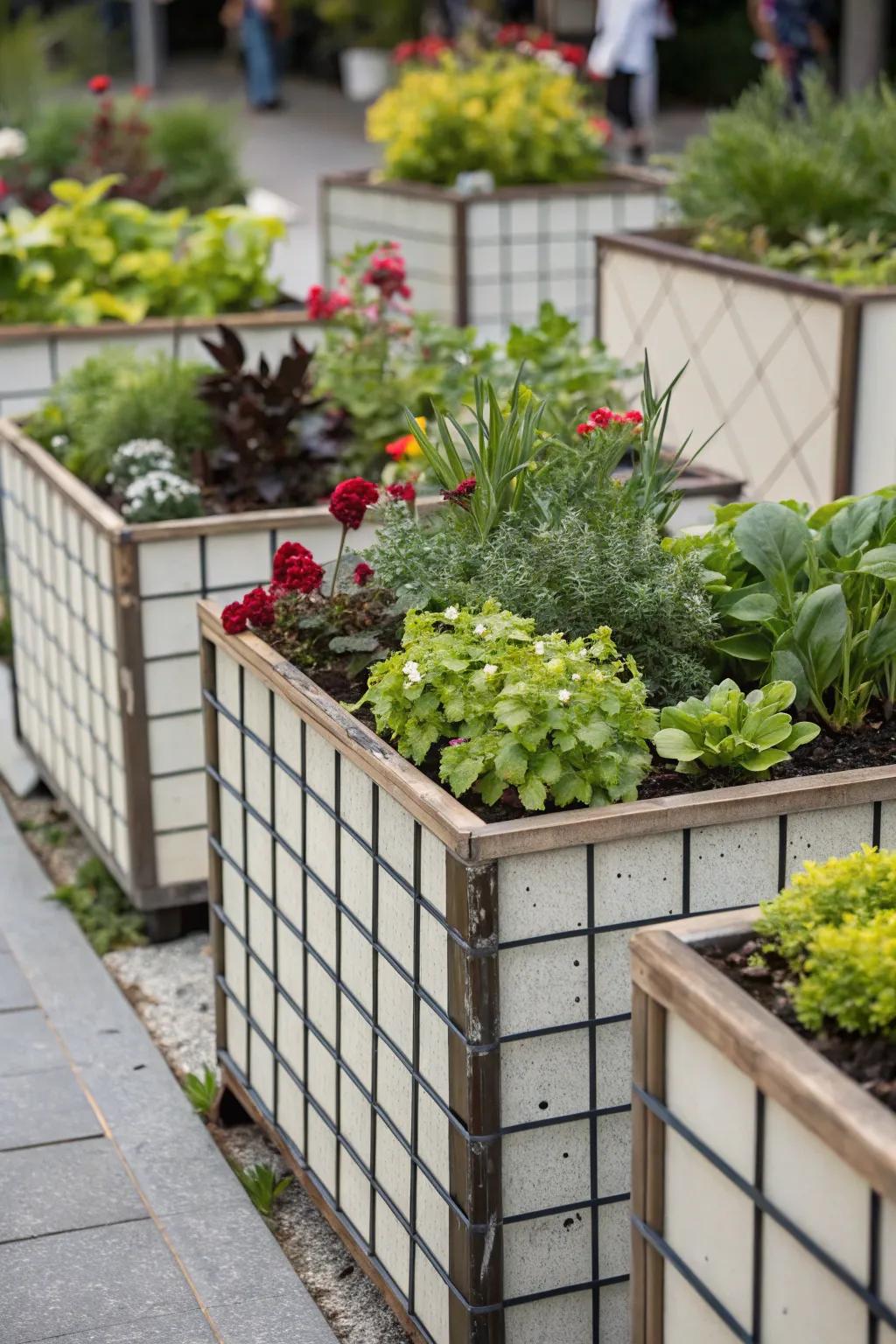
If you’re really tight on space, consider using containers with a square foot grid on top. I’ve turned many a balcony into a productive garden this way.
You might give these a try:
- Square Foot Gardening Containers: Maximize your gardening space with these versatile and compact containers, perfect for any balcony.
- Gardening Grid for Containers: Easily organize your plants using this durable gardening grid, designed for efficient use of space.
- Compact Plant Containers: Transform small areas into lush gardens with these stackable, space-saving plant containers.
18. Repurposed Materials
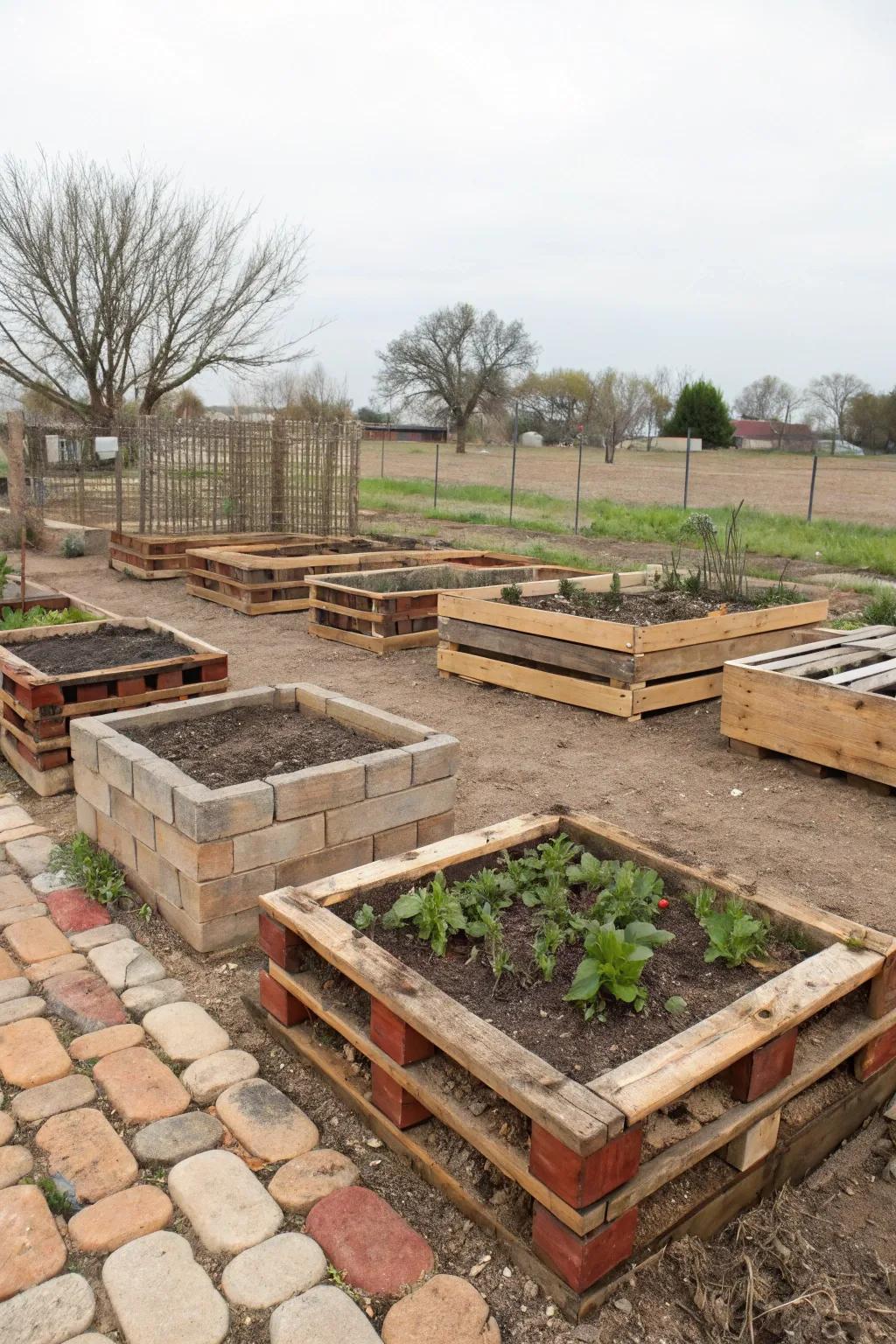
Use repurposed materials like old bricks or wooden pallets for your garden structure. It’s eco-friendly and lends a rustic charm.
Some ideas to consider:
- Reclaimed Wood Garden Bed Kit: Create a rustic garden using these reclaimed wood kits, adding charm and sustainability to your space.
- Eco-Friendly Brick Edging Set: Define your garden layout elegantly with eco-friendly brick edging, enhancing both style and function.
- Wooden Pallet Planter Box: Easily assemble a garden with these pallet planter boxes, perfect for small, sustainable spaces.
19. Fragrant Pathways
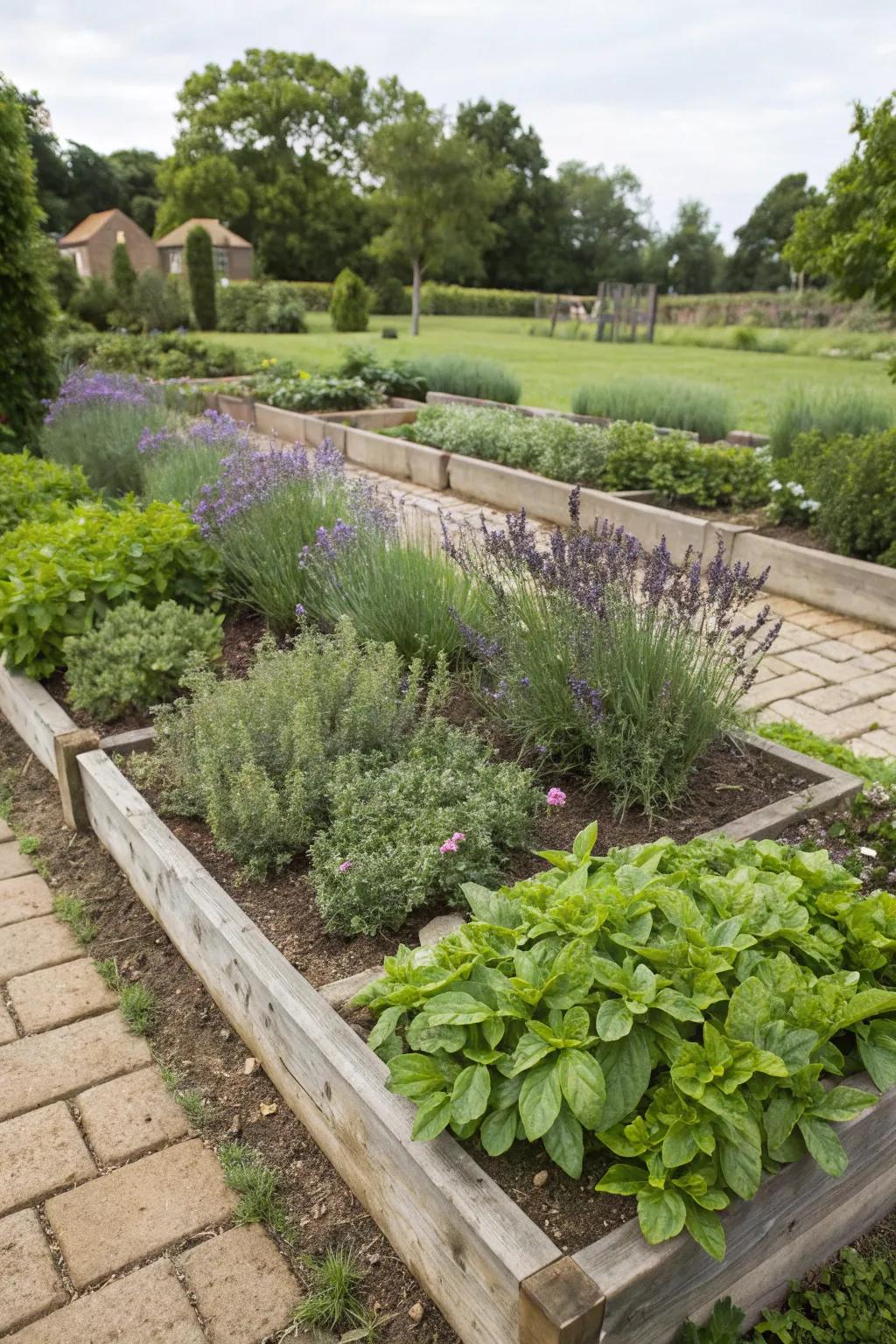
Plant fragrant herbs or flowers along the edges of your garden bed. It’s a sensory delight every time you walk by.
A few helpful options:
- Herb Seed Pack: Plant aromatic herbs and enjoy delightful scents every time you stroll by your garden.
- Fragrant Flower Mix: Add vibrant, aromatic blooms along your pathway for a sensory experience in your garden.
- Garden Kneeler and Seat: Experience comfort while tending to your fragrant plants with this versatile garden kneeler and seat.
20. Edible Borders
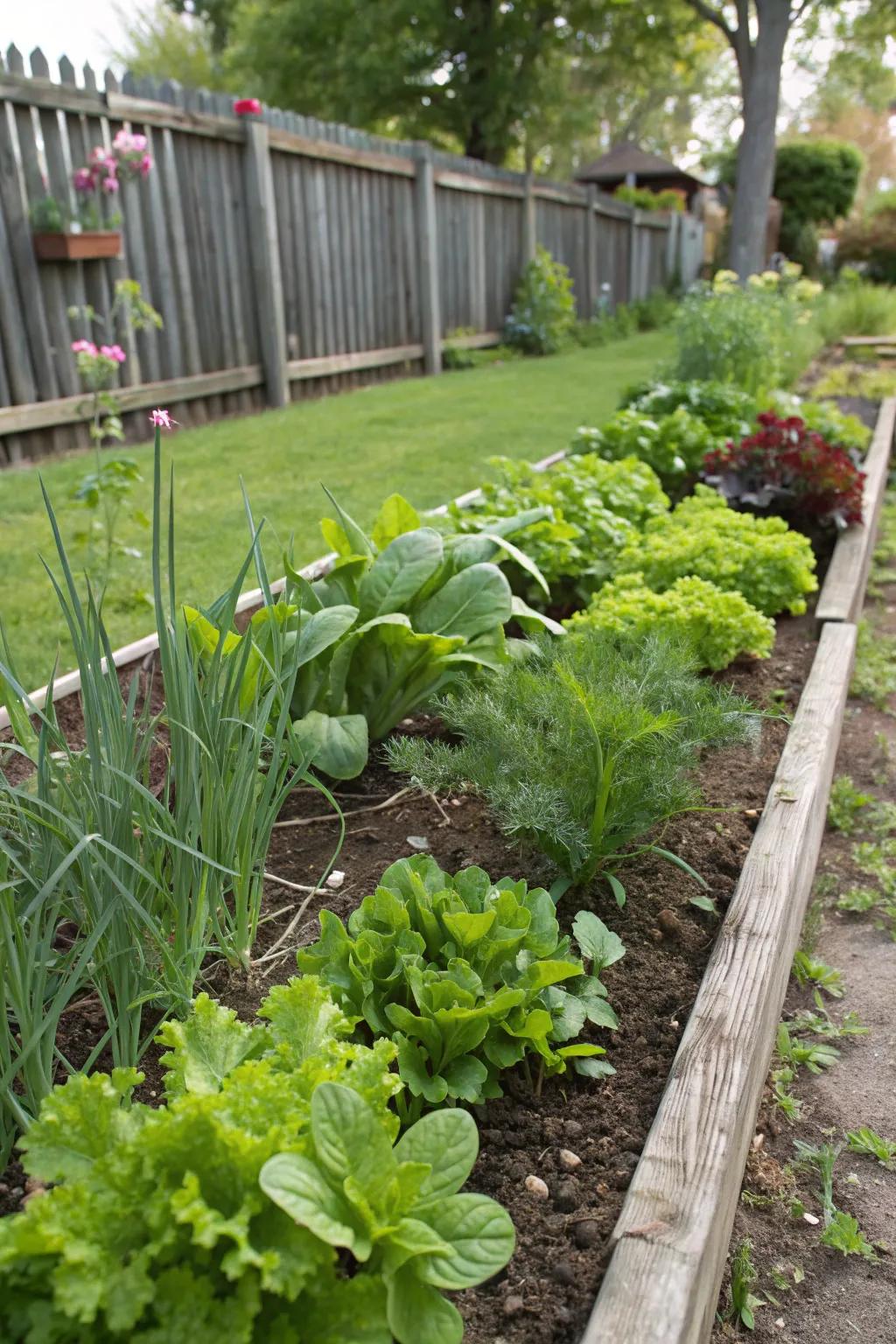
Use edible plants as borders for your garden beds. I often use chives or strawberries for a delicious and functional edge.
These products might be useful:
- Chive Seeds Pack: Grow delicious chives as a flavorful border. Easy to plant and perfect for beginners.
- Strawberry Plant Kit: Start your own strawberry border with this easy-to-use plant kit. Perfect for fresh snacks.
- Raised Garden Bed Edging: Define your edible borders with durable garden bed edging. Enhances garden layout and appearance.
21. Vertical Victory
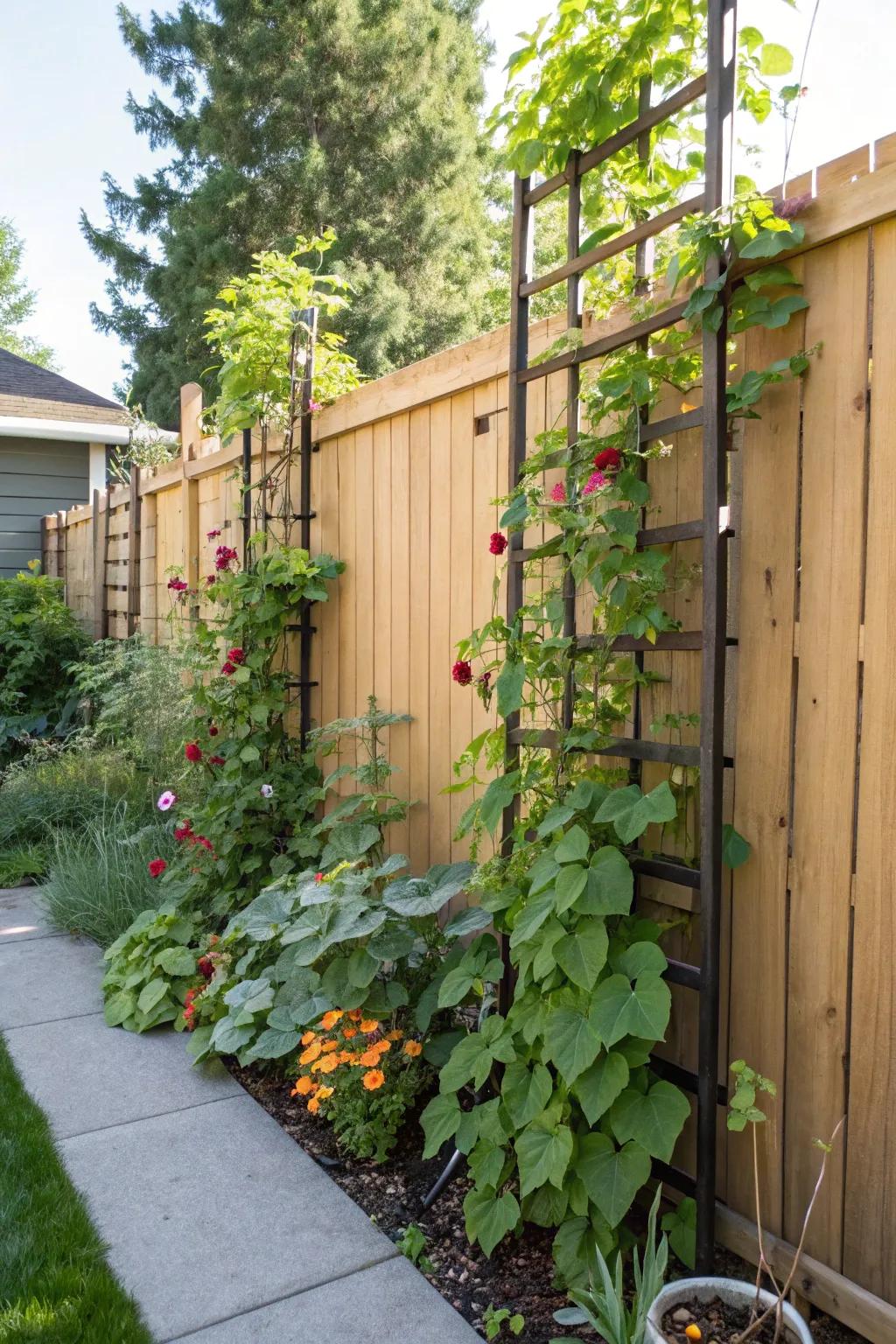
Think vertical! Adding trellises or frames for climbing plants can maximize your space. I’ve turned many a blank wall into a green tapestry this way.
Explore these options:
- Garden Trellis: Enhance your vertical garden space with a durable trellis. Perfect for climbing plants.
- Climbing Plant Support: Maximize growth with sturdy supports, ideal for enabling vines to reach new heights.
- Wall-Mounted Planter: Turn any wall into a garden with these easy-to-mount planters. Save space efficiently.
